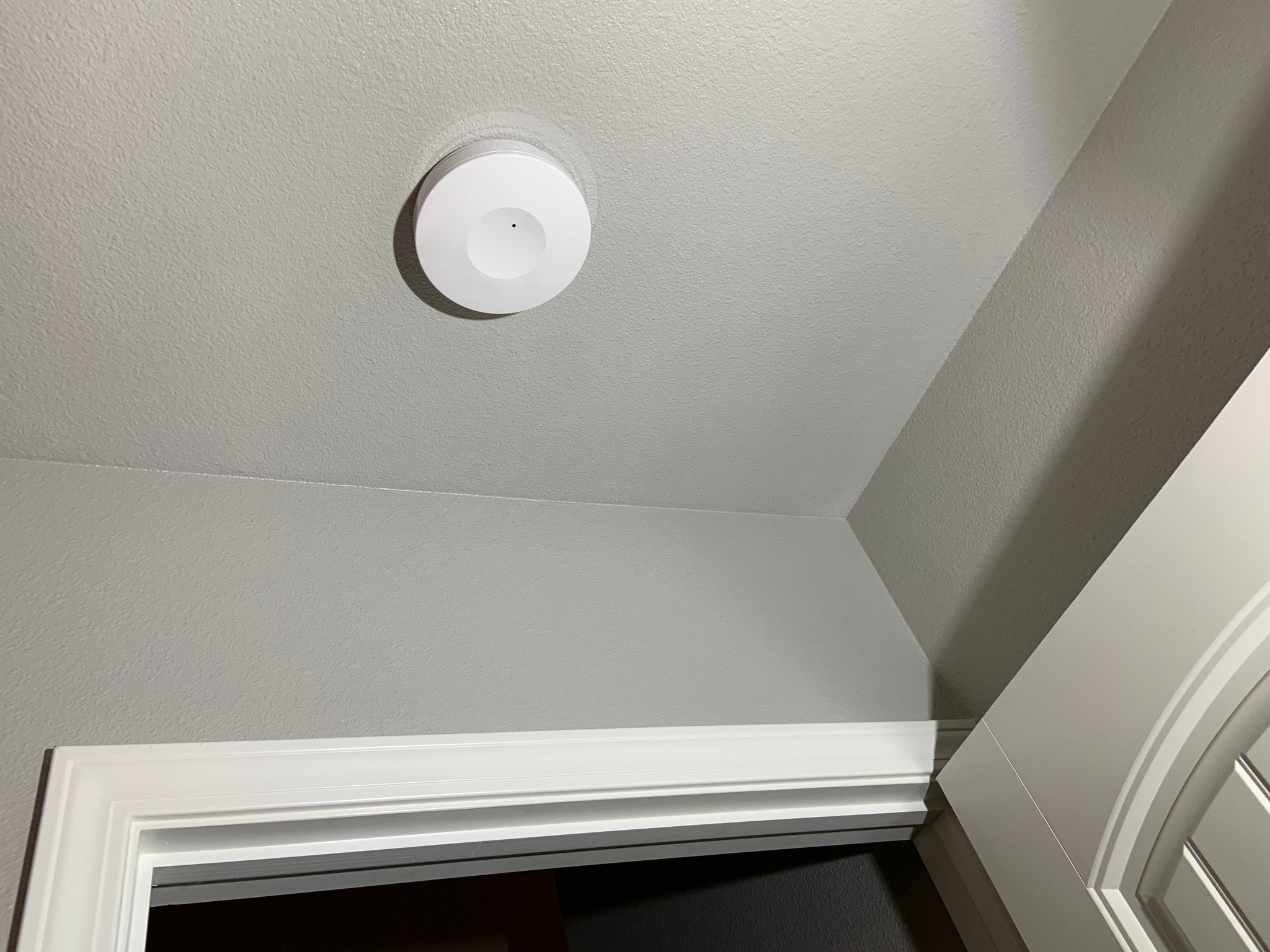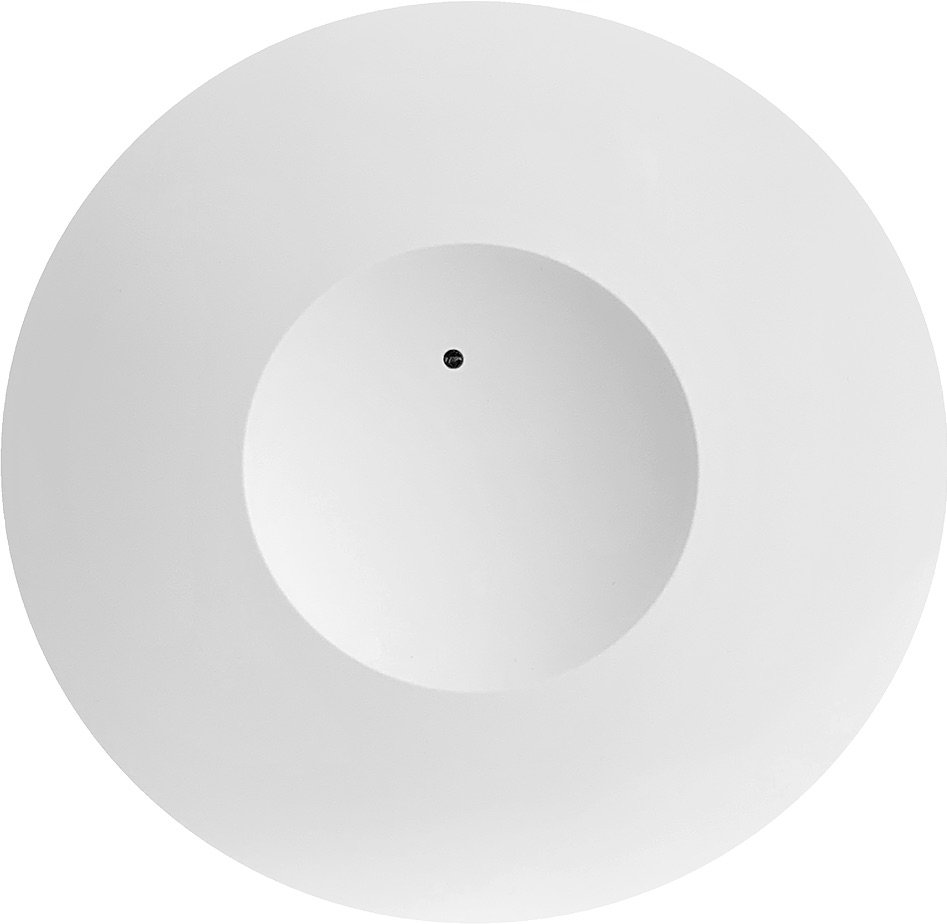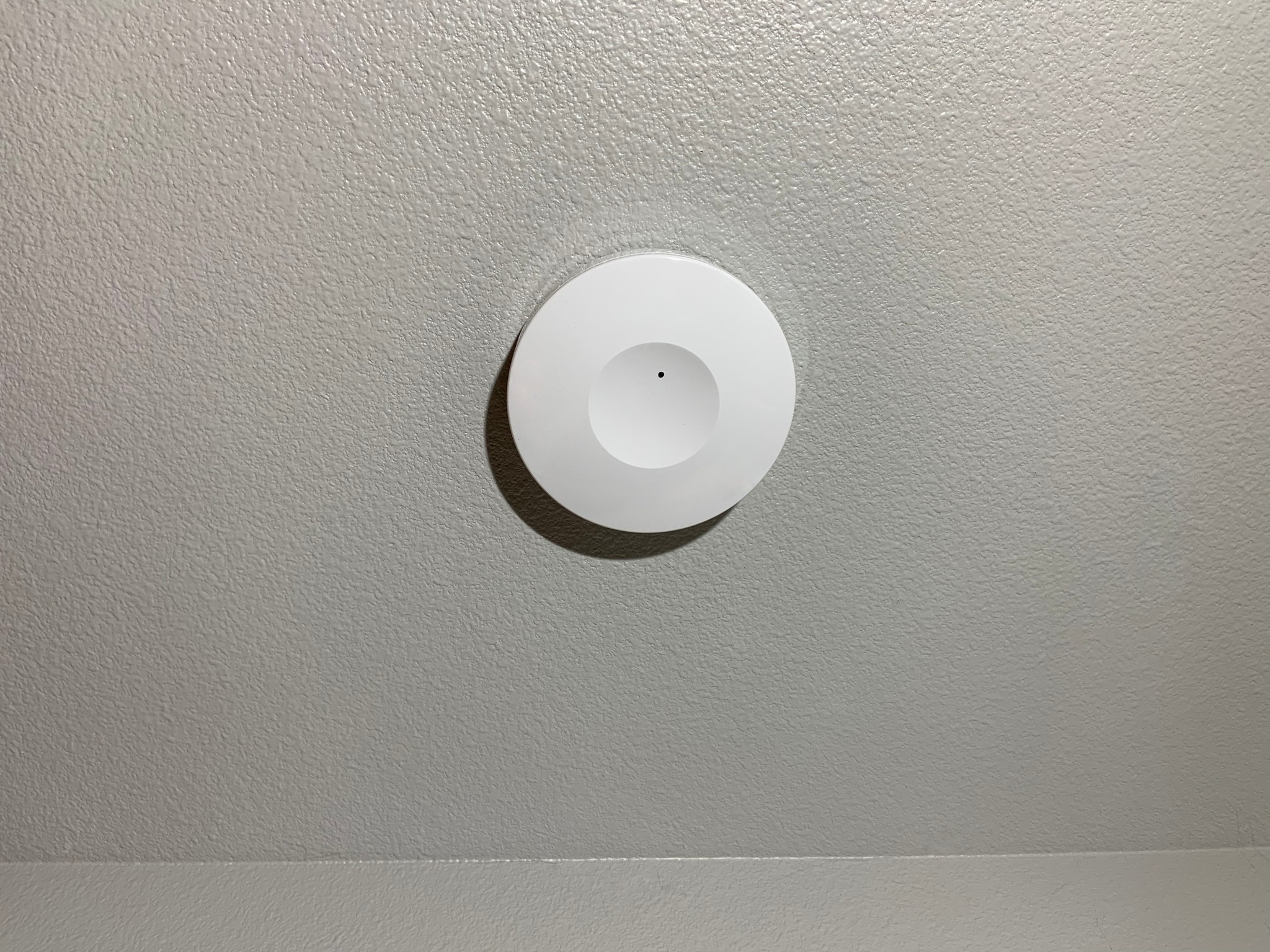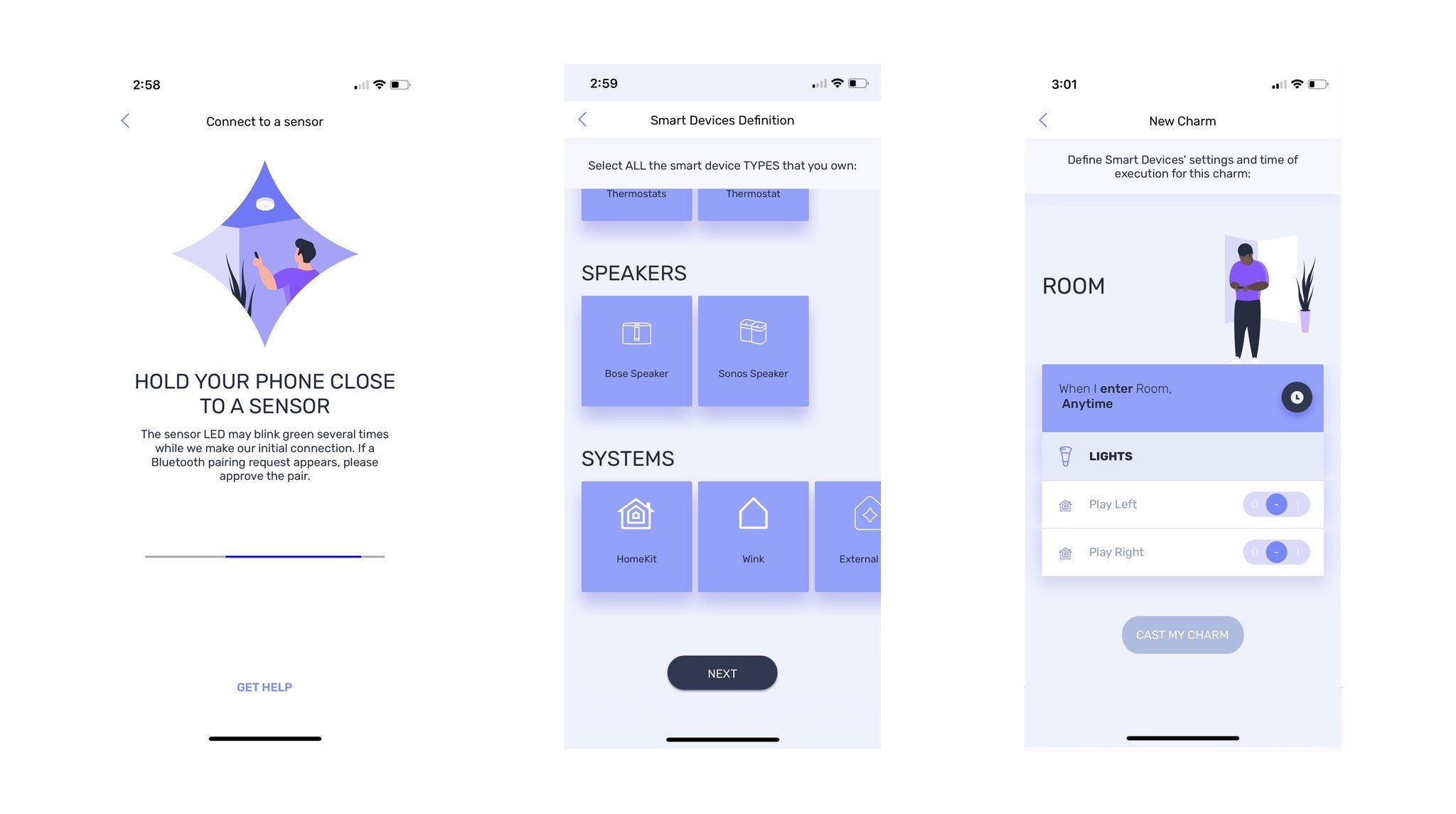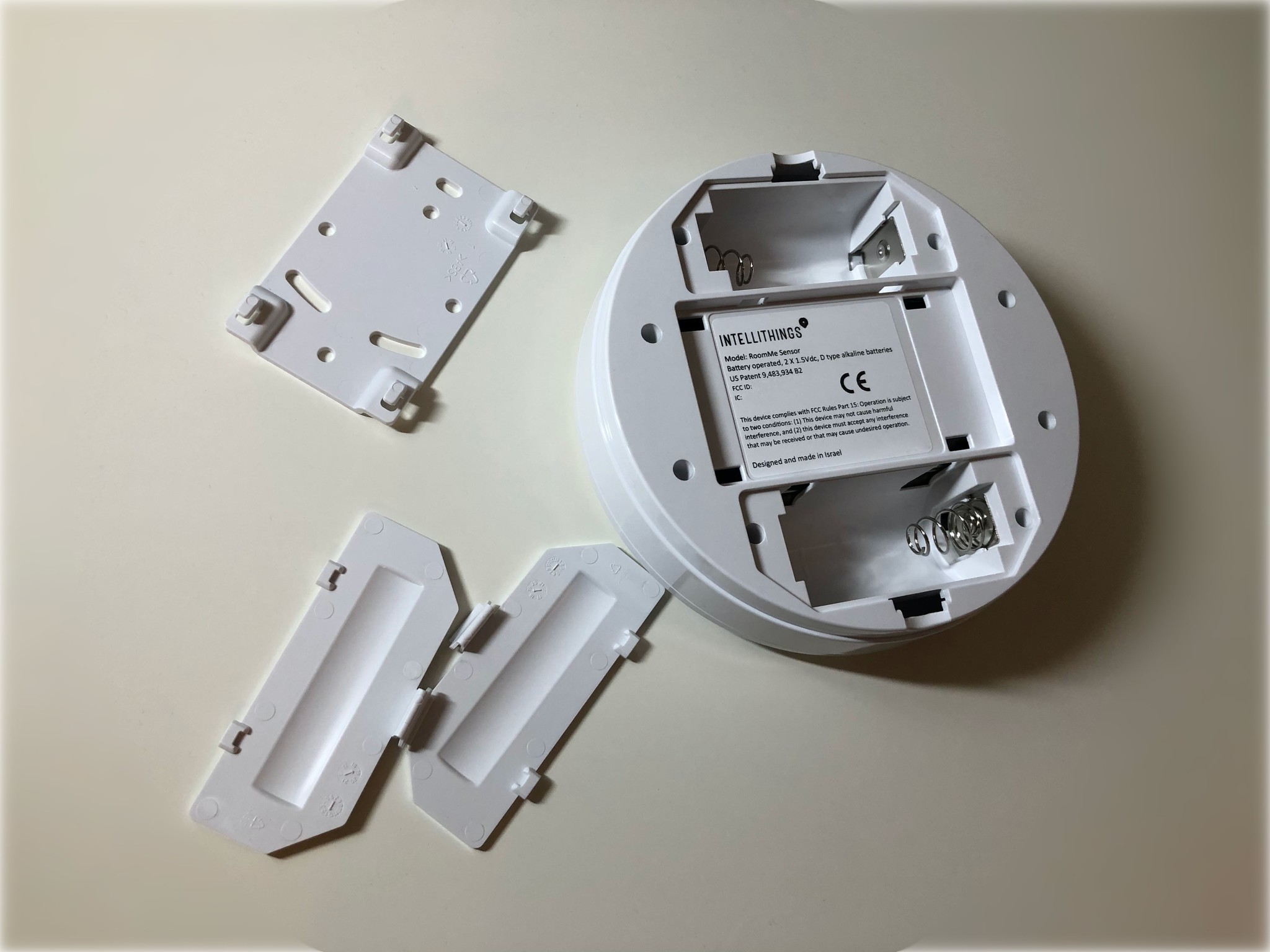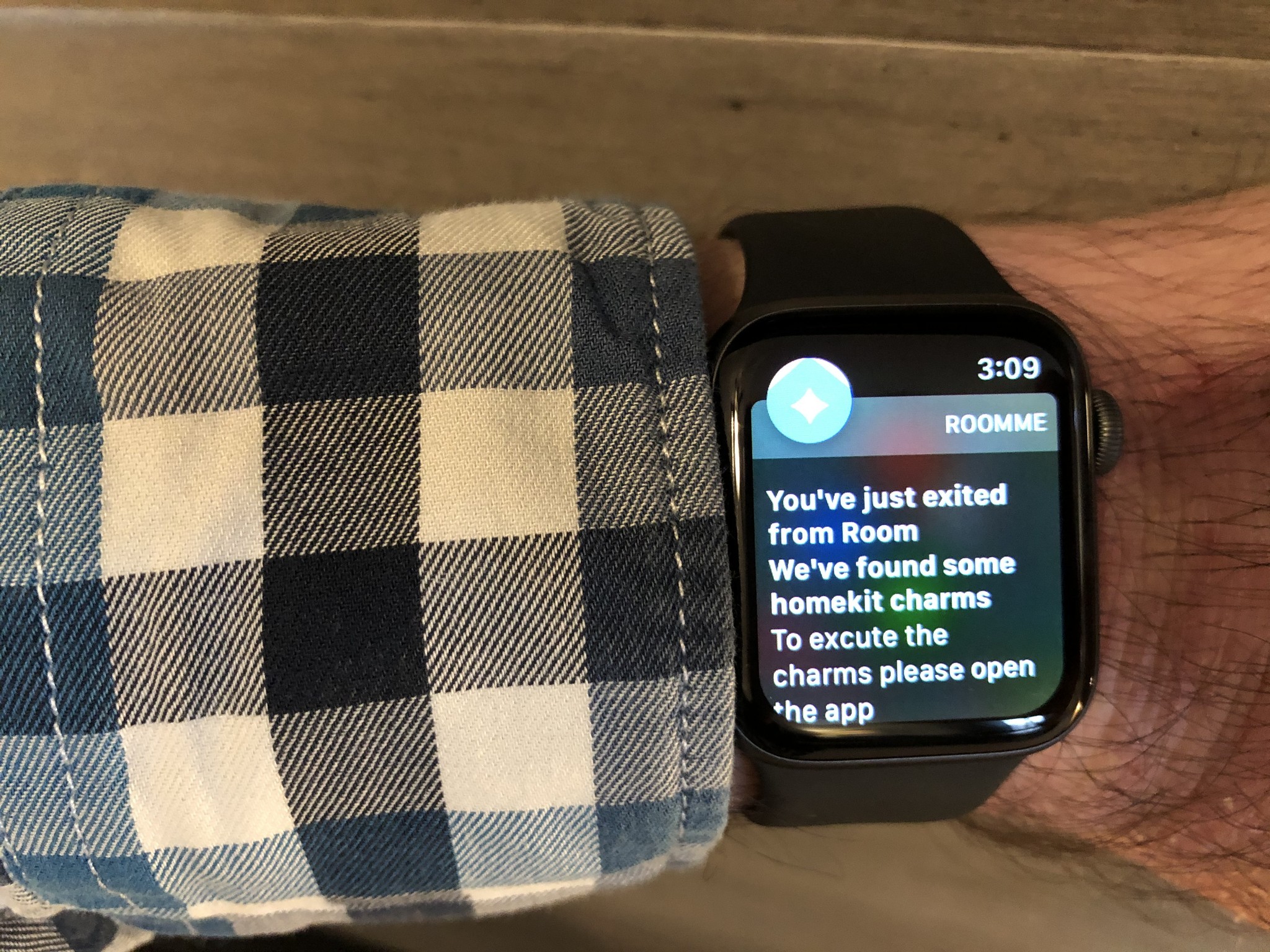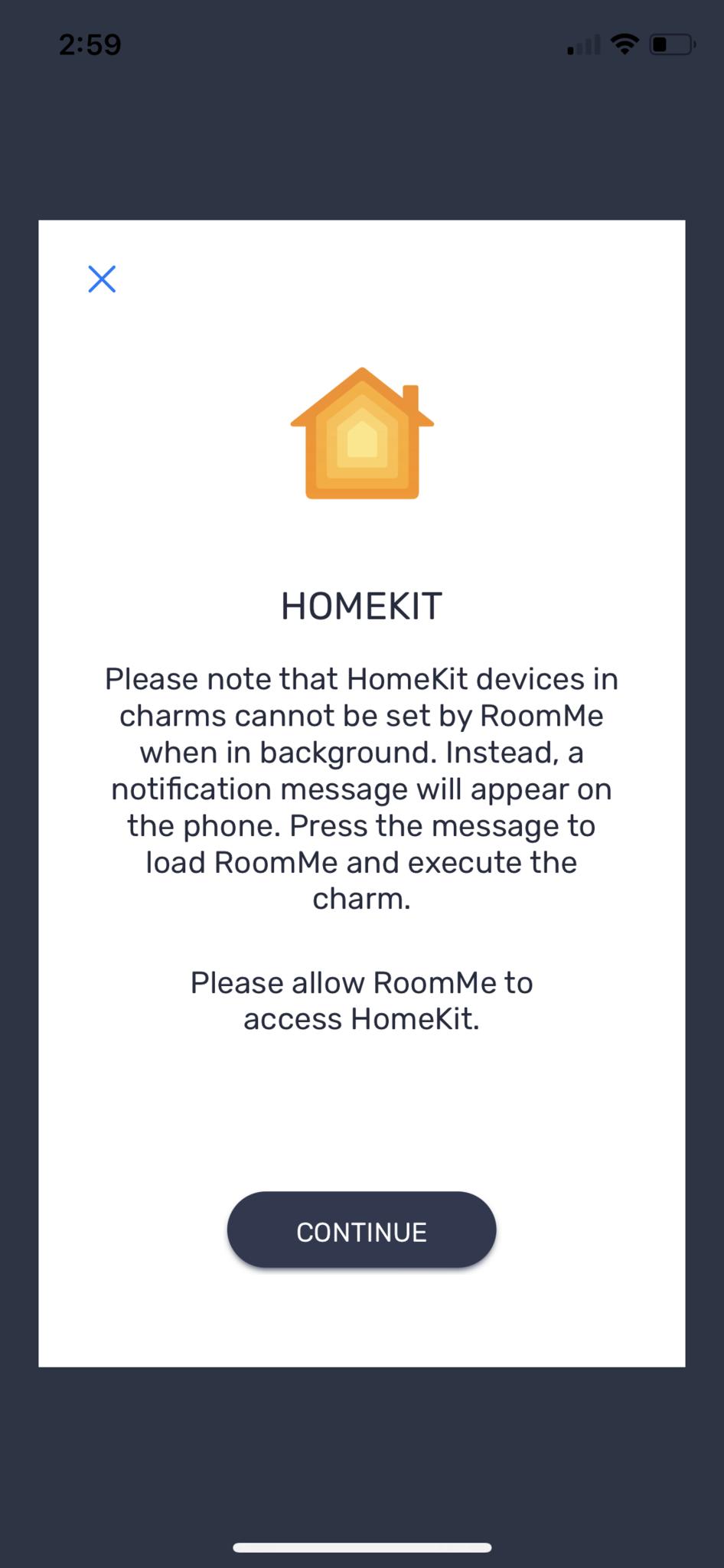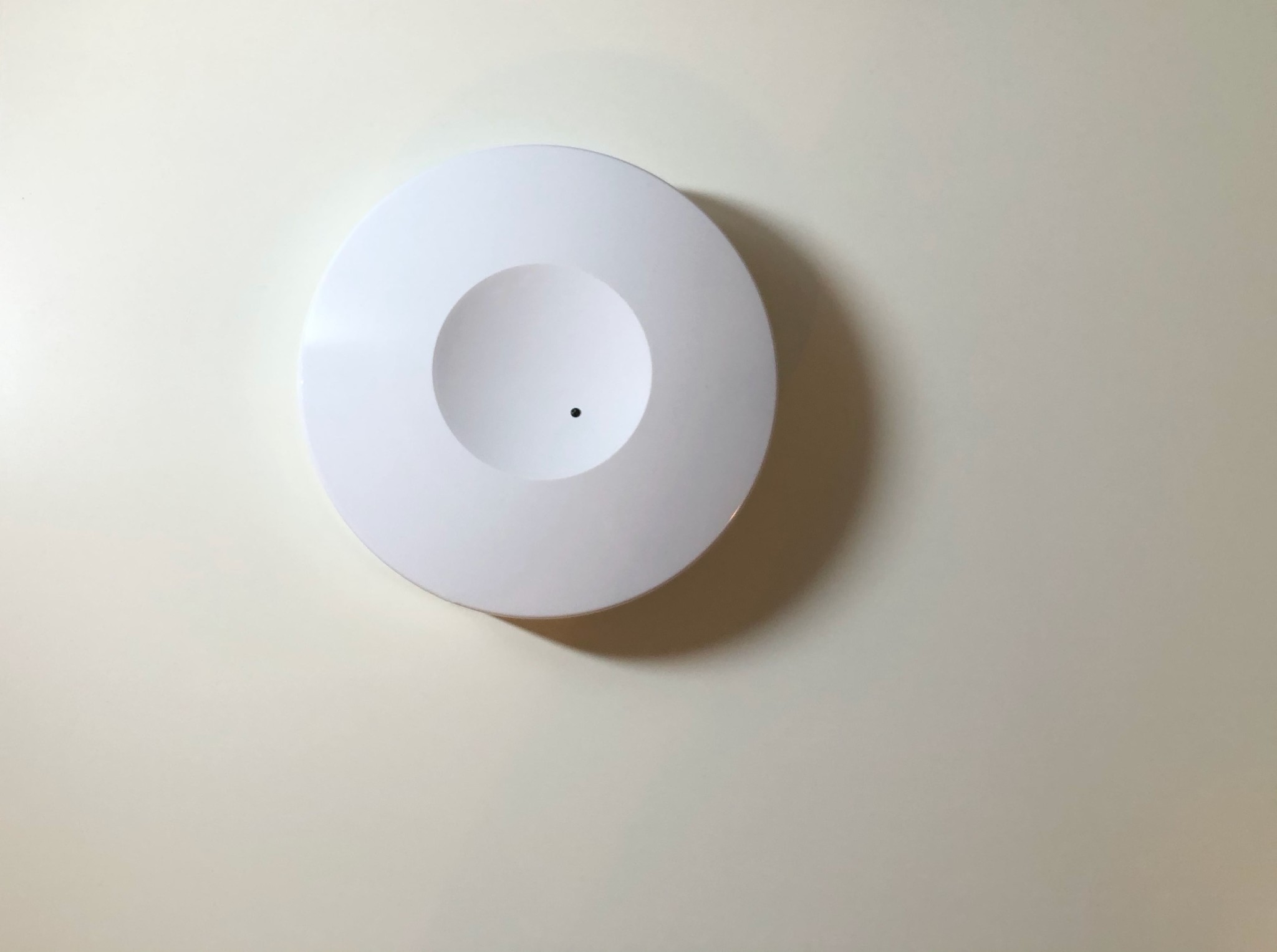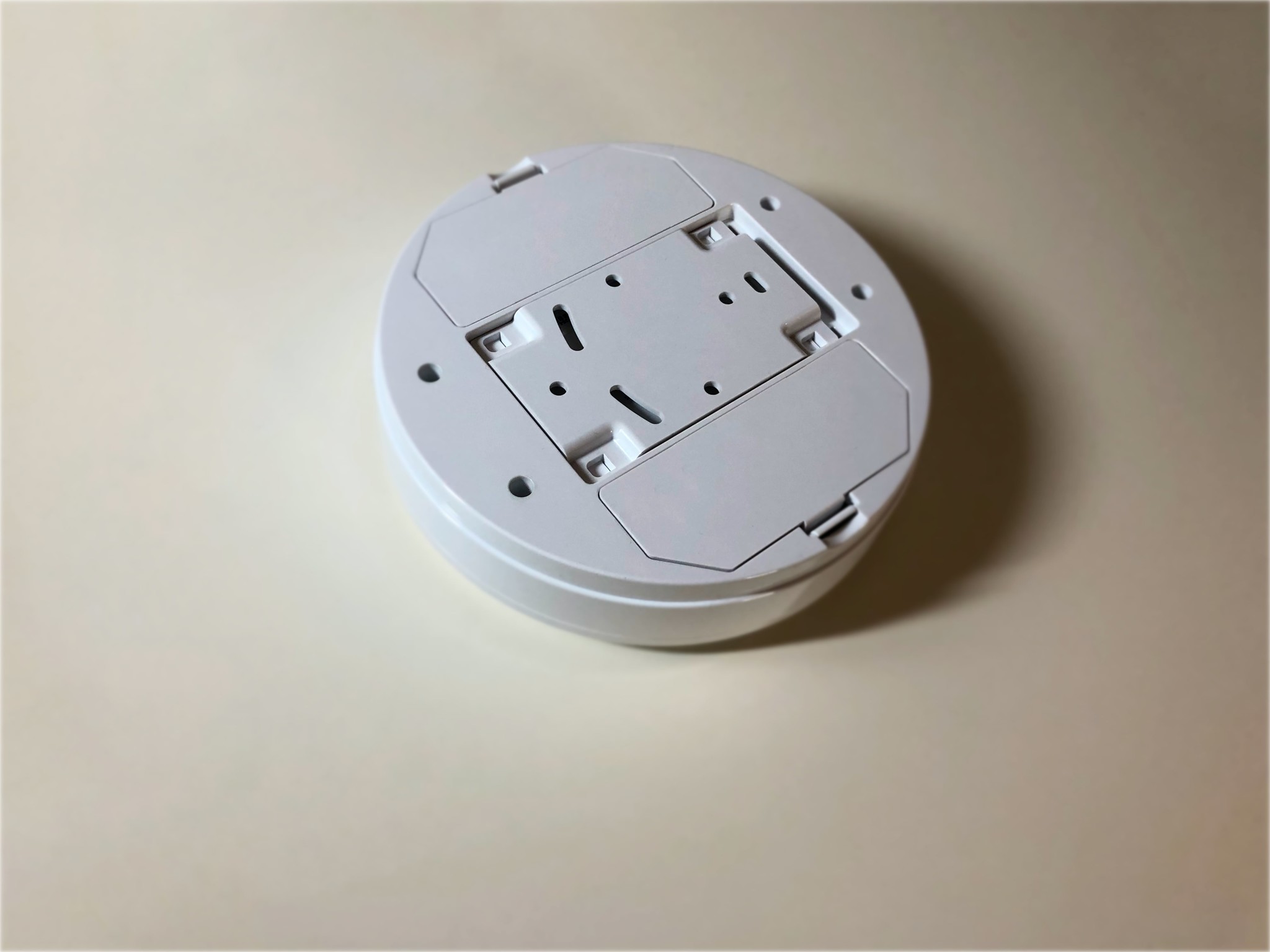Forget motion sensors, the RoomMe PLS makes automations truly personal
- feb
- 18
- Posted by Michael
- Posted in Okategoriserade
RoomMe's sensor aims to make the smart home personal.
Despite the rising popularity of modern smart home accessories leading to a bevy of different devices and platforms, there has always been one common goal: to make the home truly personal. Motion sensors and geo-fencing have bridged some of the gaps that currently exist toward that future, but motion sensors are not personal, and geo-fencing stops at the door.
I recently installed a new type of smart home accessory that takes a slightly different approach to the way automations are handled, the RoomMe Personal Location Sensor (PLS). This rather small and unassuming device installs directly on the ceiling, relying on signatures from paired phones to determine who has entered, and what accessories to toggle on.
Much to my surprise, the RoomMe PLS can deliver on a large portion of this smart home future, reacting quickly to my presence, setting things just the way that I like, and not springing to life for others. As with all things though, there are a few catches that prevent it from becoming the ultimate home smart home solution.
Personal automation
RoomMe Personal Location Sensor
Bottom line: The RoomMe PLS provides personalized automations that activate quickly upon entering a room with your connected smartphone. However, limited HomeKit support, and reliance on having your phone in hand keeps it from being a must-have accessory.
The Good
- Easy installation and setup
- Fast response times
- Works with popular smart home accessories
The Bad
- Automations require phone in hand
- Limited HomeKit integration
- Batteries not included
Above it all
RoomMe Personal Location Sensor: The features
The RoomMe PLS features a clean all-white plastic design, that is similar in size and shape of most smoke detectors. Just like with smoke detectors, the PLS is intended for installation on the ceiling, preferably above any entrances. Only one sensor is included for the price of admission, which works for common areas such as living rooms, but entire home coverage does require more than one.
The PLS unit is pretty sparse which is not a bad thing, with just a single LED indicator light and an integrated button. The back of the PLS is basic as well, with just a couple of battery slots and an indention that houses the ceiling mount. Since the RoomMe PLS is completely wireless, it does require two D batteries to power it up, which are, unfortunately, not included. While these batteries are not overly expensive or hard to find, they are not ones that everyone just has lying around, which may lead to a trip to the store.
The PLS uses Bluetooth 4 Low Energy to communicate with most smartphones and some Samsung Tizen OS smartwatches, but unfortunately not Apple Watch or Fitbit for some strange reason. Automations are stored and ran locally on the sensor, and programming the sensor occurs via the RoomMe app. When setting up a sensor, room, or adding smart accessories, the instructions are synced to the sensor, which creates a short delay, but I appreciate that it keeps things local and doesn't rely on the cloud.
Supported accessories are limited to certain categories and manufacturers, but RoomMe covers some of the more popular options such as ecobee thermostats and Philips Hue lighting. The PLS also supports smart home platforms like Apple's HomeKit, Amazon Alexa, and Google Assistant. Recent updates have expanded functionality to include Siri Shortcuts, and a neat home status report feature that can tell you who's in your home with just a shout.
Speaking of whose in your home, profiles can be set for each member of your household, allowing it to react differently depending on who enters or leaves. Thankfully, RoomMe provides users with the option to also assign priority levels, preventing scenarios where another family member's music starts blaring or overrides any current tunes just because they happened to step into the room.
Easy installation
RoomMe Personal Location Sensor: What I like
Installing and pairing the RoomMe PLS is extremely simple, with unboxing and discovering it through the associated app taking under 10 minutes. The RoomMe sensor is designed to be installed on a ceiling above an entrance but doesn't require any wiring as it is wireless. Simply install the required batteries, put in a couple of screws to secure it, and you are ready to go.
The RoomMe app walks you through account creation and the process of pairing, which uses Bluetooth to communicate to your phone that you hold near the sensor. Discovering the sensor was fast and worked on the first try, and the same was true for adding my existing smart home accessories. In my testing, I connected my Philips Hue lights directly, which required pushing the large button on the Hue hub, as well as some of my HomeKit accessories.
This was not the case at all, as the PLS picked up my phone and turned on my lighting at what seemed like the exact moment the sensor came into view, every time, which was impressive.
Once your accessories are discovered, you are now ready to create "charms", which is the term used for automations like turning on a specific device when entering. This process was again, simple with easy to understand language making setting up automations just a few taps away. In addition to setting charms for entering and leaving, you can also set them for specific times, and the app includes some neat suggestions, such as those for special occasions like an anniversary or birthday.
The performance of the RoomMe PLS was surprisingly good. Since the system relies on your smartphone to determine when to fire up charms, I expected some lag or instances where it simply failed to deliver. This was not the case at all, as the PLS picked up my phone and turned on my lighting at what seemed like the exact moment the sensor came into view, every time, which was impressive. I did notice that the default times were a little on the long side for exiting automations, but there are settings available to tweak these if needed.
Not so automated
RoomMe Personal Location Sensor: What I don't like
As I mentioned previously, the RoomMe works pretty much as advertised, turning on and off linked accessories just by walking into a room with your phone in hand. For the times where your phone isn't in your hand though, things simply do not spring to life automatically. This obviously creates some frustration when you are used to having the lights turn on for you, and it shatters the illusion of having a truly personal, smart home.
HomeKit integration with the RoomMe PLS is also rather limited, and a little disappointing. HomeKit accessories are found the same way as other devices within the RoomMe app, with a simple scan displaying what is available. However, not all HomeKit accessory types are supported, except for more common ones such as the aforementioned lighting and climate control devices. In my case, in a home with around 100 HomeKit accessories, only seven could be added as charms.
What is even more disappointing is how the system handles automations with HomeKit accessories, or rather, how it doesn't. After setting a HomeKit accessory as a charm, and entering or leaving a room with the associated sensor installed, automations will not fire up automatically. Instead, you will receive a notification on your iPhone or Apple Watch letting you know that you entered the room and that in order to run your automation, you must open the app.
Granted, RoomMe is upfront about this with a prompt that informs users of how HomeKit integration works when going to scan for accessories, but it is still a bummer that hampers the overall experience. In the case of Philips Hue lighting that is tied to HomeKit, you can simply connect the Hue hub directly to the RoomMe app, bypassing HomeKit, which allows things to work as intended. In some cases though, you may have accessories that do not have direct integration with the app, and connecting them through HomeKit is the only option, creating a not so automated experience.
Truly personal
RoomMe Personal Location Sensor: The Bottom Line
At the end of the day, the RoomMe PLS partially accomplishes its main task of being a truly personalized automation system. The sensor responds quickly to the presence of your smart home, lighting up your home, or playing your favorite tunes just by entering a room, which is quite a pleasant experience when it is all set in motion.
However, its usefulness is ultimately tied to what you put into it, if you have your phone in hand, and which accessories you currently have in your home. While most major smart accessories are covered, such as Philips Hue lighting products, there may be some cases where some of your devices are left out of the automation party. HomeKit accessories also require that extra confirmation before running automations, which makes it not quite so automatic.
We are certainly closer to the home of the future with accessories like the RoomMe Personal Location Sensor, and I am looking forward to seeing how it evolves through updates. Correcting just a few shortcomings is all that is needed to make the PLS a must-have smart home accessory, so here's to hoping these fixes, like the personal home of the future, come sooner rather than later.
Personal automation
RoomMe Personal Location Sensor
Bottom line: The RoomMe PLS provides personalized automations that activate quickly upon entering a room with your connected smartphone. However, limited HomeKit support, and reliance on having your phone in hand keeps it from being a must-have accessory.
Senaste inläggen
- New Apple Pencil report makes it sound like the PS5 controller – no, really
- Apple could be springing a big surprise with M4 chip debut on iPad Pro
- Apple has realized what the iPad’s best feature is after 14 years — and its Let Loose event will make it clear
- Mimestream, my favorite Mac email app, is getting an iOS version
- Apple-ID loggar ut användare och kräver lösenordsåterställning
Senaste kommentarer
Arkiv
- april 2024
- mars 2024
- februari 2024
- januari 2024
- december 2023
- november 2023
- oktober 2023
- september 2023
- augusti 2023
- juli 2023
- juni 2023
- maj 2023
- april 2023
- mars 2023
- februari 2023
- januari 2023
- december 2022
- november 2022
- oktober 2022
- september 2022
- augusti 2022
- juli 2022
- juni 2022
- maj 2022
- april 2022
- mars 2022
- februari 2022
- april 2021
- mars 2021
- januari 2021
- december 2020
- november 2020
- oktober 2020
- september 2020
- augusti 2020
- juli 2020
- juni 2020
- maj 2020
- april 2020
- mars 2020
- februari 2020
- januari 2020
- december 2019
- november 2019
- oktober 2019
- september 2019
- augusti 2019
- juli 2019
- juni 2019
- maj 2019
- april 2019
- mars 2019
- februari 2019
- januari 2019
- december 2018
- november 2018
- oktober 2018
- september 2018
- augusti 2018
- juli 2018
- juni 2018
- maj 2018
- april 2018
- mars 2018
- februari 2018
- januari 2018
- december 2017
- november 2017
- oktober 2017
- september 2017
- augusti 2017
- juli 2017
- juni 2017
- maj 2017
- april 2017
- mars 2017
- februari 2017
- januari 2017
- december 2016
- november 2016
- oktober 2016
- september 2016
- augusti 2016
- juli 2016
- juni 2016
- maj 2016
- april 2016
- mars 2016
- februari 2016
- januari 2016
- december 2015
- november 2015
- oktober 2015
- september 2015
- augusti 2015
- juli 2015
- juni 2015
- maj 2015
- april 2015
- mars 2015
- februari 2015
- januari 2015
- december 2014
- november 2014
- oktober 2014
- september 2014
- augusti 2014
- juli 2014
- juni 2014
- maj 2014
- april 2014
- mars 2014
- februari 2014
- januari 2014
Kategorier
- –> Publicera på PFA löp
- (PRODUCT) RED
- 2015
- 25PP
- 2nd gen
- 32gb
- 3D Touch
- 3D-kamera
- 4k
- 64gb
- 9to5mac
- A10
- A9X
- Aaron Sorkin
- Accessories
- adapter
- AirPlay
- AirPods
- Aktiv
- Aktivitetsarmband
- Aktuellt
- Alfred
- AMOLED
- Android Wear
- Angela Ahrendts
- Ångerätt
- announcements
- Ansiktsigenkänning
- app
- App Store
- Appar
- Apple
- Apple Beta Software Program
- Apple Book
- Apple CarPlay
- Apple Event
- Apple iMac
- Apple Mac Mini
- Apple Macbook
- Apple MacBook Air
- Apple MacBook Pro
- Apple Macos
- Apple Maps
- Apple Music
- Apple Music Festival
- Apple Music Radio
- Apple Offer
- Apple Online Store
- Apple Park
- Apple Pay
- Apple Pencil
- Apple Podcast
- Apple Store
- Apple Store 3.3
- Apple TV
- apple tv 4
- Apple TV 4K
- Apple Watch
- Apple Watch 2
- Apple Watch 8
- Apple Watch 9
- Apple Watch Apps
- Apple Watch SE
- Apple Watch Series 2
- Apple Watch Sport
- Apple Watch Ultra
- AppleCare
- AppleTV
- Application
- Applications
- Apps
- AppStore
- Apptillägg
- Apptips
- AppTV
- April
- Arbetsminne
- armband
- Art Apps
- Återköp
- återvinning
- Åtgärdsalternativ
- atvflash
- Audio Apps
- Augmented REality
- Back-to-school
- Bakgrundsbilder
- BankId
- Barn
- Batteri
- batteriskal
- batteritid
- Beats
- Beats 1
- Beats Solo 2 Wireless
- Beats Solo2
- Bebis
- Beginner Tips
- Belkin
- Bendgate
- beta
- Beta 3
- betaversion
- betaversioner
- bilddagboken.se
- bilder
- bilhållare
- billboard
- Bioteknik
- Blendtec
- Bloomberg
- Bloons TD 5
- Bluelounge
- Bluetooth
- Böj
- Booking.com
- Borderlinx
- bose
- bugg
- Buggar
- Buggfixar
- Butik
- C More
- Calc 2M
- Camera
- Campus 2
- Canal Digital
- Carpool Karaoke
- Caseual
- Catalyst
- CES 2015
- Chassit
- Chip
- Chrome Remote Desktop
- Chromecast
- citrix
- clic 360
- CNBC
- Connect
- Cydia
- Dagens app
- Dagens tips
- Damm
- Danny Boyle
- Data
- datamängd
- Datorer
- Datortillbehör
- Datum
- Defense
- Dekaler
- Designed by Apple in California
- Developer
- Development
- Digital Inn
- Digital Touch
- Digitalbox
- DigiTimes
- Direkt
- Discover
- display
- DisplayMate
- Dive
- Docka
- Dräger 3000
- Dropbox
- Droples
- DxOMark
- E-post
- earpod
- EarPods
- Earth Day
- Eddie Cue
- eddy cue
- Educational Apps
- Ekonomi
- Ekonomi/Bransch
- El Capitan
- Elements
- ElevationLab
- Elgato Eve
- Elgato Eve Energy
- EM 2016
- Emoji
- emojis
- emoticons
- Enligt
- EU
- event
- Eventrykten
- EverythingApplePro
- Faceshift
- facetime
- Fäste
- Featured
- Features
- Feng
- Film / Tv-serier
- Filmer
- Filstorlek
- Finance Apps
- Finder For AirPods
- Finland
- FireCore
- Fitbit
- Fitness Accessories
- Fjärrstyr
- Flurry
- Födelsedag
- fodral
- Förboka
- Force Touch
- förhandsboka
- Första intryck
- Forumtipset
- foto
- FoU (Forskning och Utveckling)
- Fource Touch
- Foxconn
- FPS Games
- Framtid
- Fre Power
- Frontpage
- Fullt
- Fuse Chicken
- Fyra
- Gadgets
- Gagatsvart
- Gamereactor
- Games
- Gaming
- Gaming Chairs
- Gästkrönika
- General
- Gigaset
- Gitarr
- Glas
- GM
- Google Maps
- Google Now
- gratis
- grattis
- Guide
- Guider
- Guider & listor
- Guld
- hack
- Halebop
- hållare
- Hälsa
- Hårdvara
- HBO
- HBO Nordic
- Health
- Health and Fitness
- Health and Fitness Apps
- Hej Siri
- Helvetica Neue
- Hemelektronik
- Hemknapp
- Hemlarm
- Hermes
- Hitta min iphone
- Hjärta
- högtalare
- HomeKit
- HomePod
- hörlurar
- htc
- Hue
- Humor
- i
- I Am A Witness
- IBM
- iBolt
- iBomber
- iBook
- icar
- iCloud
- iCloud Drive
- iCloud Voicemail
- iCloud.com
- iDevices
- IDG Play
- idownloadblog
- iFixit
- ikea
- iKörkort
- iLife
- Illusion Labs
- iMac
- IMAP
- iMessage
- iMessages
- iMore Show
- Incipio
- InFuse
- Inspelning
- Instagram-flöde
- Instrument
- Intel
- Internet/Webbtjänster
- iOS
- iOS 10
- iOS 12
- iOS 17
- iOS 18
- iOS 5
- iOS 7
- iOS 8
- iOS 8 beta
- iOS 8.1.3
- iOS 8.2
- iOS 8.3
- iOS 8.4
- iOS 8.4.1
- iOS 9
- iOS 9 beta 4
- iOS 9.1
- iOS 9.1 beta 2
- iOS 9.2
- iOS 9.2.1
- iOS 9.3
- IOS Games
- ios uppdatering
- ios9
- iPad
- iPad Accessories
- iPad Air
- iPad Air 2
- iPad Air 3
- iPad Apps
- iPad Mini
- iPad mini 4
- iPad Mini 6
- iPad mini retina
- iPad Pro
- iPados
- iphone
- iPhone 12
- iPhone 14
- iPhone 14 Pro
- iPhone 15
- iPhone 16
- iPhone 17
- iPhone 5
- iPhone 5S
- iPhone 5se
- iPhone 6
- iphone 6 plus
- iPhone 6c
- iPhone 6s
- iPhone 6S plus
- iPhone 7
- iPhone 7 display
- iPhone 7 Plus
- iPhone 7s
- iPhone Accessories
- iPhone Apps
- iPhone SE
- iphone x
- iPhone XS
- iPhone XS Max
- iPhone7
- iPhoneGuiden
- iPhoneguiden.se
- iPhones
- iPod
- iPod Nano
- iPod shuffle
- ipod touch
- iSight
- iTunes
- iWatch
- iWork
- iWork för iCloud beta
- Jailbreak
- James Corden
- Jämförande test
- Jämförelse
- Jet Black
- Jet White
- Jönssonligan
- Jony Ive
- Juice Pack
- Juridik
- Just mobile
- kalender
- kalkylator
- Kamera
- Kameratest
- Karriär/Utbildning
- Kartor
- Kevin Hart
- keynote
- Keynote 2016
- KGI
- KGI Security
- Kina
- Klassiskt läderspänne
- Kod
- Kollage
- koncept
- konceptbilder
- köpguide
- krasch
- Krascha iPhone
- Krönika
- Kvartalsrapport
- Laddhållare
- laddningsdocka
- Laddunderlägg
- läderloop
- lagar
- Lagring
- Lajka
- Länder
- lansering
- laserfokus
- Layout
- leather loop
- LG
- Liam
- Lifeproof
- Lightnigport
- lightning
- Linux
- LinX
- live
- Live GIF
- Live Photos
- Live-event
- Livsstil
- Ljud & Bild
- Logitech
- LOL
- Lösenkod
- Lösenkodlås
- Lovande spel
- LTE
- Luxe Edition
- M3
- M3TV
- Mac
- Mac App Store
- Mac Apps
- Mac Mini
- Mac OS
- Mac OS X
- Mac OS X (generellt)
- Mac OS X Snow Leopard
- Mac Pro
- Macbook
- Macbook Air
- Macbook Pro
- Macforum
- Macintosh
- macOS
- Macs
- MacWorld
- Made for Apple Watch
- magi
- Magic
- MagSafe
- Martin Hajek
- matematik
- Meddelanden
- Media Markt
- Medieproduktion
- Mediocre
- Messaging Apps
- Messenger
- MetaWatch
- Mfi
- Michael Fassbender
- microsoft
- Mikrofon
- Minecraft
- Ming-Chi Kuo
- miniräknare
- minne
- Mixer
- Mixning
- Mjukvara
- mobbning
- Mobile Content
- Mobilt
- Mobilt/Handdator/Laptop
- Mobiltelefon
- Mockup
- Mophie
- mors dag
- moto 360
- Motor
- MTV VMA
- multitasking
- Music
- Music Apps
- Music, Movies and TV
- Musik
- Musikmemon
- MW Expo 2008
- native union
- Nätverk
- Navigation Apps
- nedgradera
- Netatmo Welcome
- Netflix
- Netgear Arlo
- News
- Niantic
- Nike
- Nikkei
- Nintendo
- Nöje
- Norge
- Notis
- Notiscenter
- nya färger
- Nyfödd
- Nyheter
- Officeprogram
- Okategoriserade
- OLED
- omdöme
- Omsättning
- OS X
- OS X El Capitan
- OS X Mavericks
- OS X Yosemite
- Outlook
- Övrig mjukvara
- Övrigt
- PanGu
- papper
- patent
- PC
- pebble
- Pebble Smartwatch
- Pebble Steel
- Pebble Time
- Pebble Time Steel
- Persondatorer
- Petter Hegevall
- PewDiePie
- Philips
- Philips Hue
- Phones
- Photoshop
- Planet of the apps
- Plex
- Pluggar
- Plus
- Plusbox
- Podcast
- Podcast Apps
- Policy
- Porträttläge
- PP
- Pris
- priser
- problem
- Problems
- Productivity Apps
- Program
- Prylar & tillbehör
- Publik
- publik beta
- QuickTime
- räkenskapsår
- räkna
- ram
- RAM-minne
- Rapport/Undersökning/Trend
- Rea
- Reading Apps
- recension
- Red
- reklaamfilm
- reklam
- reklamfilm
- reklamfilmer
- rekord
- Rendering
- reparation
- Reportage
- Reptest
- ResearchKit
- Retro
- Review
- Ring
- Ringa
- Rocket Cars
- Rosa
- Rumors
- Rumours
- RunKeeper
- rykte
- Rykten
- Safir
- Säkerhet
- Säkerhetsbrist
- Samhälle/Politik
- samsung
- Samtal
- San Francisco
- SAP
- security
- Series 2
- Servrar
- Shigeru Miyamoto
- Sia
- Siri
- SJ Min resa
- skal
- Skal iPhone 6
- skal iPhone 6s
- skärm
- SKärmdump
- Skärmglas
- Skribent
- skribenter medarbetare
- Skriva ut
- skruvmejsel
- skydd
- Skyddsfilm
- Skype
- slice intelligence
- Smart
- smart hem
- Smart Home
- Smart Keyboard
- Smart klocka
- Smart Lights
- smartphone
- Smartwatch
- Snabbt
- Snapchat
- Social Apps
- Software
- Solo2
- sommar
- Sonos
- Sony
- soundtouch
- Space Marshals
- spår
- Speakers
- Special Event
- Spel
- Spelkonsol
- Spellistor
- Split Screen
- Split View
- Sport
- Sportband
- Sports Apps
- spotify
- Spring forward
- Statistik
- Steve Jobs
- Stickers
- Stockholm
- Stor iPhone
- Storlek
- Story Mode
- Strategy Games
- streama
- Streaming
- stresstest
- Ström
- Studentrabatt
- stylus
- Super Mario Run
- support
- Surf
- Surfplatta
- svenska
- sverige
- Sverigelansering
- Switch
- Systemstatus
- Systemutveckling
- tåg
- Taig
- Tangentbord
- Taptic Engine
- Tårta
- tät
- Tävling
- Taylor Swift
- Teknik
- tele 2
- Telefoner
- Telekom
- Telia
- Test
- Tid
- TikTok
- Tile
- tillbehör
- Tim Cook
- TIME
- TimeStand
- Tiny Umbrella
- Tips
- Toppnyhet IDG.se
- Touch ID
- TouchID
- tower defence
- trådlös laddning
- Trådlösa hörlurar
- trådlöst
- trailer
- Travel Apps
- Tre
- TrendForce
- TripAdvisor
- Trolleri
- trump
- TSMC
- Tum
- tv
- tvätta
- tvOS
- tvOS 9.2
- tvOS beta 2
- Tweak
- Typsnitt
- Ubytesprogram
- UE MegaBoom
- Unboxing
- Underhållning/Spel
- unidays
- United Daily News
- Unix
- Updates
- Uppdatera
- uppdatering
- Upplösning
- upptäckt
- USA
- Ut på Twitter
- utbyte
- utbytesprogram
- Utilities Apps
- Utlottning
- utrymme
- utvecklare
- varumärke
- Vatten
- Vattentålig
- vattentät
- vävt nylon
- Verktyg
- Viaplay
- Vibrator
- video
- Videoartiklar och webb-tv (M3/TW/CS)
- Villkor
- viloknapp
- Virtual Reality
- Virus
- visa
- Vision Pro
- VLC
- Volvo on call
- W1
- Waitrose
- Watch OS
- WatchOS
- WatchOS 2
- watchOS 2.0.1
- watchOS 2.2
- Webbtv (AppTV)
- wi-fi
- Wifi-samtal
- Windows
- Windows 8
- WWDC
- WWDC2015
- yalu
- Youtube
- Zlatan

